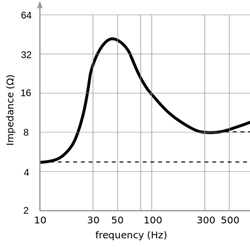
Since both terminators are in parallel, the left output sees a lower impedance than it’s used to. It was designed to drive a load of 10 kohms or so, and it now sees less than 150 ohms. This places a huge strain on the CD players output stage.
Same idea with plugging a keyboards stereo outputs into the parallel 1/4-inch jacks on a DI box. The parallel jacks are literally wired directly into each other, so this would be the equivalent of plugging the keyboard’s outputs straight into each other with a single cable, which no one thinks is a good idea.
Whenever you “Y” together multiple outputs (lo-Z) into an input (hi-Z), impedance dictates that the outputs will drive each other. Results may vary, from no audible change to distortion, to the device overheating, overloading, and shutting off. It’s best not to risk it, especially given the affordability of passive combiner boxes.
On the bright side, sometimes we can take advantage of parallel jacks in creative ways thanks to the impedance situation. I toured with a hip-hop artist who had her wireless receiver racked with a channel strip and an in-ear transmitter. The IEM system, an entry-level model with front-panel inputs, was driven directly from a rear-panel output on the channel strip.
To facilitate this, there was an unsightly and awkward XLR cable running from the back of the rack and around to the front. Further investigation revealed rear-panel parallel outs on the transmitter.
Using a short XLR patch cable and a female-to-female adapter, we were able to patch the output from the channel strip into the “output” on the transmitter. This works because the device’s inputs and outputs are literally wired directly together internally, so the transmitter’s input stage does not know or care which jack is used (Figure 3).
I used the same trick once in a venue with permanently installed mic lines from the stage to front of house – and not returns. At FOH, I used a female-female adapter to patch the board’s mix outputs to unused mic lines.
Then I realized that since the wedge were powered models with parallel XLR outputs, I could drive them via their outputs without having to use male-male adapters on the stage end. I could even daisy chain several wedges together “backwards,” output to input. This is not a game changer, but it saves time and reduces the number of adapters in my signal chain, so I’m all for it.
At last, we’ve arrived at the end of our journey through the strange lands of impedance. It’s my hope that this article helped you learn about a new concept or things about signal flow in a new way. If I’ve managed to save even one amplifier from an untimely and undignified demise, I’ll count it as a success.
Jonah Altrove is a veteran live audio professional on a constant quest to discover more about the craft.

